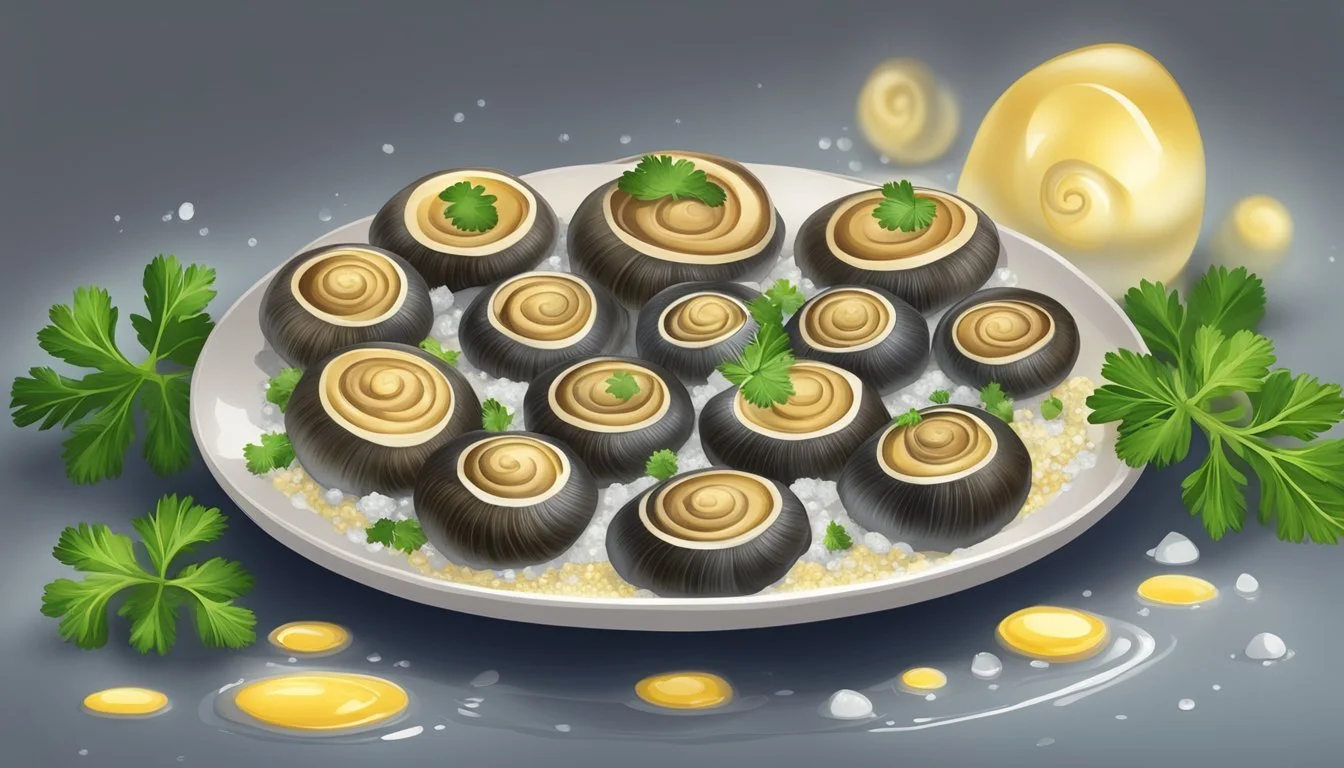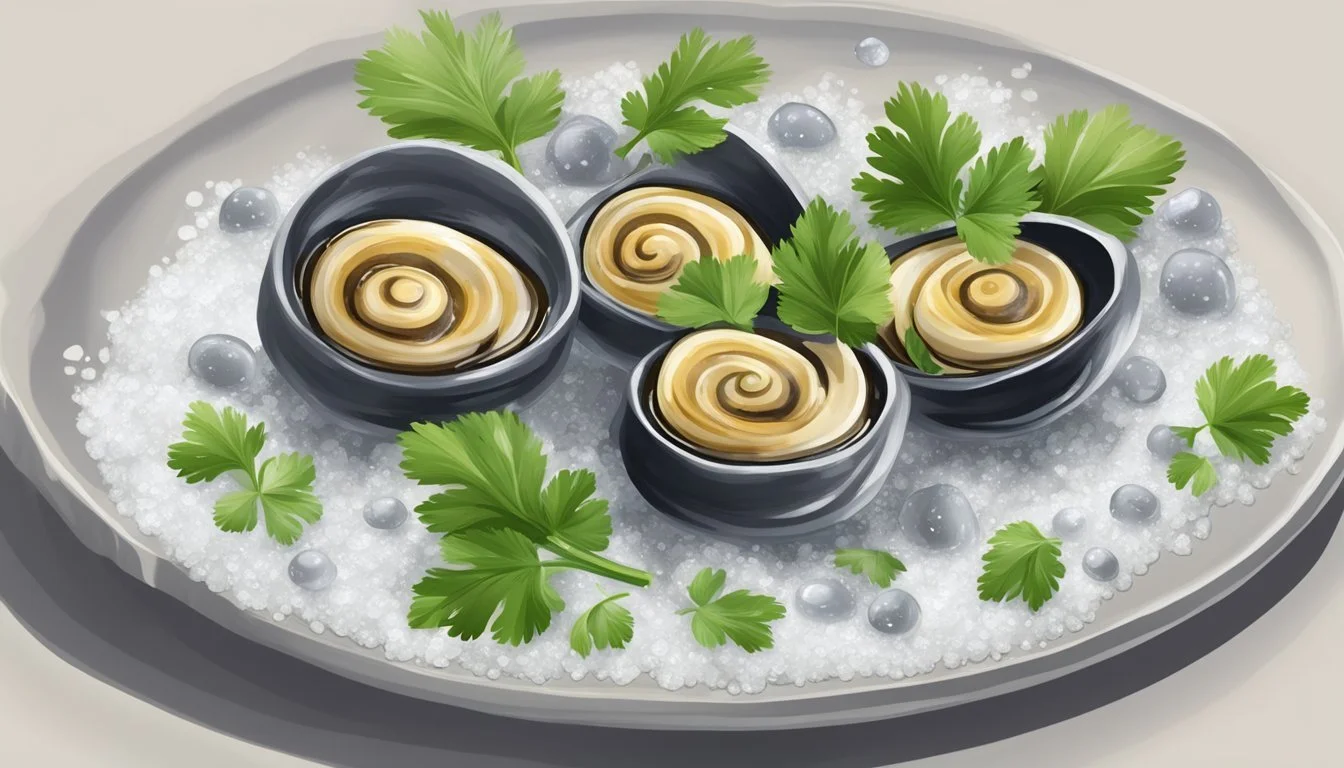Escargot
Unveiling the Delicacy of French Buttered Snails
Escargot, the French term for edible snails, is a delicacy that has woven its way into the tapestry of French cuisine. Esteemed for their distinctive flavor and tender texture, these mollusks are often prepared with a rich garlicky butter sauce that accentuates their subtle taste. Historically, the popularity of snails as a gourmet dish surged in 19th century France, though their culinary use dates back to ancient times.
Renowned for being served in their shells and smothered with a sumptuous mixture of butter, garlic, and parsley, escargot dishes are a staple in French gastronomy. They are emblematic of the luxurious aspects of French dining, combining simple ingredients to create a sophisticated appetizer. The freshness of the parsley in the dish is not just a garnish; it plays a crucial role in balancing the flavors, providing a counterpoint to the rich and savory butter.
Escargot is often associated with haute cuisine, but it has a broad appeal due to its unique taste and texture. It's frequently enjoyed on festive occasions and in fine dining establishments, yet it can also be prepared at home with the help of easily accessible recipes. Whether indulging in a Paris bistro or experimenting in one's own kitchen, escargot continues to be a beloved feature of culinary exploration in French food (What wine goes well with French food?) culture.
Understanding Escargot
Escargot exemplifies French gastronomy with meticulous species selection and recognized nutritional qualities. It is a traditional French dish synonymous with luxury and refined taste.
History and Popularity
Escargot has a storied history, emerging as a culinary staple in France that dates back centuries. The dish's popularity transcends French borders, esteemed globally for its rich flavor and connection to French culinary artistry. Traditionally served as an appetizer, escargot is considered a symbol of the nation's gastronomic heritage.
Species and Selection
The most sought-after species for escargot is Helix pomatia, also known as Burgundy snails. The selection of snails for escargot is a precise process, with preference given to certain land snails that are known for their superior flavor and texture. These snails are typically purged, removed from their shells, and then prepared with a blend of garlic, butter, and herbs.
Nutritional Profile
Escargot harbors a nutritional profile rich in:
Protein: Essential for muscle and tissue repair.
Iron: Crucial for blood production and energy.
Fiber: Beneficial for digestive health.
Here's a quick glance at the nutritional elements per 100 grams of escargot:
Calories: 90 kcal
Protein: 16g
Total Fat: 1.4g
Saturated Fat: 0.4g
Unsaturated Fat: Trace amounts
Cholesterol: 50mg
Carbohydrates: 2g
Fiber: 0g
Sugar: 0g
Sodium: 70mg
Iron: 3.5mg
Trans Fat: 0g
While low in carbohydrates, sugar, and other fats like trans and saturated fats, escargot is deemed a nutriment-dense food, making it a preferred choice among health-conscious diners seeking a luxurious yet healthful indulgence.
Preparation Essentials
When preparing escargot, one must carefully select quality ingredients and have the proper kitchen tools on hand to ensure a classic French culinary experience.
Choosing the Right Ingredients
The foundation of a good escargot recipe lies in its ingredients. Snails should be of the highest quality, often sold canned and pre-prepared for convenience. Fresh snail shells can be acquired separately if the snails don't come with shells. Essential for the classic 'Escargots à la Bourguignonne' is a compound butter mixture seasoned with garlic, parsley, shallot, salt, pepper, and sometimes a touch of nutmeg and white wine. Each ingredient contributes to the rich flavor profile characteristic of this luxurious French appetizer.
Kitchen Tools Required
Several specialized kitchen tools aid in the preparation and serving of escargots. Here is a brief list:
Snail Tongs & Forks: Snail tongs are used to hold the shell while escargot forks are used to extract the meat.
Baking Sheet/Muffin Tin: A muffin tin can serve as an alternative to an escargot dish to keep the snails and butter in place while they bake.
Oven: A preheated oven, typically around 375°F to 450°F, is indispensable for cooking the snails to a tender finish.
Escargot Dish (Optional): A traditional escargot dish has depressions to hold each snail and its accompanying butter.
All tools should be ready before starting to cook to streamline the preparation process.
The Classic Recipe
The traditional preparation of escargot focuses on a rich, garlic butter sauce often complemented with white wine and herbs, showcasing the flavors while keeping the snails tender.
Escargot à la Bourguignonne
Ingredients:
Canned snails: 24
Unsalted butter, softened: 1/2 cup
Minced garlic: 2 tablespoons
Chopped parsley: 1/4 cup
Finely diced shallot: 1 tablespoon
Salt: 1/4 teaspoon
Ground black pepper: 1/4 teaspoon
Dry white wine: 2 tablespoons (optional)
Escargot shells: 24
Instructions:
Preheat the oven to 400°F (200°C).
In a bowl, mix the softened butter with minced garlic, chopped parsley, diced shallot, salt, pepper, and white wine until well combined.
Place a small amount of the garlic butter mixture into each escargot shell.
Insert one snail into each shell and then fill the shells with the remaining butter mixture.
Arrange the shells in a snail dish or on a baking sheet and bake for about 10 minutes, until the butter is sizzling.
This recipe captures the essence of Escargot à la Bourguignonne with its savory garlic butter that melds perfectly with the delicate flavors of the snails.
Alternative Variations
Though Escargot à la Bourguignonne is a classic, chefs often introduce variations to the traditional recipe.
Puff Pastry: Some recipes encase the snail and butter mixture in puff pastry for a textured contrast.
Herbs and Spices: Incorporating different herbs like tarragon or adding a hint of nutmeg can offer a new taste profile.
Serving Medium: Instead of shells, snails can also be served in small ramekins or atop slices of crusty brioche.
Each variation on the classic recipe aims to enhance the dining experience by either adding new flavors or modifying the texture. However, they all revolve around high-quality escargot and a flavorful garlic butter sauce.
Serving and Presentation
When serving escargot, the goal is to enhance the flavor of the snails with complementary accompaniments and an elegant presentation that suits both informal gatherings and special occasions.
Accompaniments
Escargot is traditionally served with crusty bread such as a toasted baguette, which provides a textural contrast to the tender snails. The bread plays a pivotal role, as it is often used to soak up the flavorful garlic-herb butter. On special occasions, escargot may also serve as an appetizer to a more substantial main dish, providing a sophisticated start to a multi-course meal.
Main Bread Accompaniments:
Crusty French bread
Toasted baguette slices
Plating Techniques
For plating, escargot is customarily served in their snail shells or in specialized gratin dishes with recesses to hold each snail. Presentation is key, and chefs typically ensure each shell or hollow is filled with the requisite amount of butter sauce, garnished with herbs for a fresh appearance.
Plating Options:
Snail shells
Gratin dishes
When served in their shells, the snails are often paired with snail tongs and a narrow fork to allow for ease of handling and consumption. Presentation in gratin dishes is equally traditional, permitting the escargot to be broiled until the butter is bubbling before serving, which further accentuates the dish's aromatic allure.
Culinary Considerations
In the realm of French cuisine, the preparation of escargot demands a balance of flavor and texture, complemented by strategic wine pairings.
Texture and Taste
Escargot is renowned for its tender texture and nuanced flavor profile. After a meticulous purging process, the snails are typically removed from their shells and cooked. The most classic preparation involves escargot bathed in garlic butter, often with the addition of chicken stock or white wine to enhance the taste. The flesh of cooked snails strikes a delicate balance, neither too chewy nor too soft, capturing a clean, earthy essence. Parsley is a common herb added to the sauce for its fresh, peppery notes, contributing to the overall gustatory experience.
Wine Pairings
Chardonnay: A white Burgundy with buttery and oaky notes - Complements the butter-based sauce
Champagne: With crisp acidity and effervescence - Cuts through the richness of the dish
Burgundy: Red Burgundy pairs well with escargot prepared in stock-based sauces with herbs - Matches the complexity of the dish
Selecting a wine to accompany escargot is pivotal for enhancing the dining experience. A buttery Chardonnay from the Burgundy region is a traditional choice, its rich flavor harmonizing with the buttery sauce of the dish. Alternatively, the vivacity of Champagne offers a refreshing counterbalance to the dish’s indulgent profile. For a red wine option, a Burgundy can also be a suitable match, particularly when the preparation includes a more robust, stock-based sauce twined with hearty herbs.
Cultural Significance
In examining the cultural significance of escargot, one must explore its deep-rooted position in French culture along with its pervasive impact on global cuisine.
Escargot in French Culture
Escargot is not just a dish but a reflection of French culinary tradition and heritage, particularly linked with the Burgundy region where it is widely claimed to have originated. These edible land snails hold a prestigious spot in French cuisine and are commonly associated with luxury and fine dining experiences. The preparation of escargot typically involves a purging process, followed by removing the snails from their shells and cooking them with ingredients like garlic butter, imbuing them with a rich, savory flavor profile.
Burgundy Region: Significance in French Cuisine
Origin of Escargot: Considered a signature French dish
Culinary Reputation: Known for a tradition of gastronomy
Global Influence
Escargot has transcended French borders, influencing culinary practices worldwide. As a quintessential French food, it acts as a gastronomic ambassador in international French restaurants, showcasing a piece of French culture. The transformation of a simple mollusk into a gourmet delicacy is seen as a testament to France's ability to elevate cooking into an art form. The global presence of escargot in many ways reflects the broad reach and respect for French cuisine, inviting diners across the world to experience a taste of France.
Health and Dietary Information
Escargot is recognized for its unique culinary status and also offers various nutritional benefits. When considering including escargot in a diet, it's important to analyze its macronutrient profile and be aware of potential allergies and intolerances.
Understanding Macronutrients
Escargots are a good source of protein and provide essential amino acids. Regarding their macronutrient content, escargots are notably low in carbohydrates and sugars, making them a potentially suitable option for low-carb diets. They contain a varying amount of fats, with a presence of both saturated and unsaturated fats. Here is a brief outline of their macronutrient values:
Protein: Essential for muscle repair and growth.
Fat: The unsaturated fats contribute to heart health.
Carbohydrates: Minimal in escargots, mostly absent of fiber.
Calories: Relatively low in calories, depending on preparation.
Calories: 90 kcal
Protein: 16g
Total Fat: 1g (Varies)
Saturated Fat: 0.4g
Trans Fat: 0g
Unsaturated Fat: Trace amounts
Cholesterol: 50mg
Sodium: 70mg
Carbohydrates: 2g
Fiber: 0g
Sugar: 0g
Iron: 3.5mg
Allergies and Intolerances
Individuals allergic to mollusks or shellfish may react to escargots as they are also classified as mollusks. Symptoms of an allergic reaction can include hives, itching, or more severe responses such as anaphylaxis. It is recommended that those with a history of these allergies approach escargot with caution or seek medical advice before consumption. Because escargot is high in cholesterol and sodium, those monitoring their heart health or blood pressure should consider these factors in their dietary choices.






